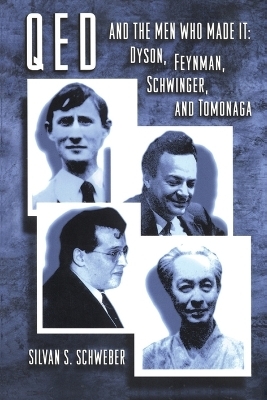
QED and the Men Who Made It
Princeton University Press (Verlag)
978-0-691-03327-3 (ISBN)
In the 1930s, physics was in a crisis. There appeared to be no way to reconcile the new theory of quantum mechanics with Einstein's theory of relativity. Several approaches had been tried and had failed. In the post-World War II period, four eminent physicists rose to the challenge and developed a calculable version of quantum electrodynamics (QED), probably the most successful theory in physics. This formulation of QED was pioneered by Freeman Dyson, Richard Feynman, Julian Schwinger, and Sin-Itiro Tomonaga, three of whom won the Nobel Prize for their work. In this book, physicist and historian Silvan Schweber tells the story of these four physicists, blending discussions of their scientific work with fascinating biographical sketches. Setting the achievements of these four men in context, Schweber begins with an account of the early work done by physicists such as Dirac and Jordan, and describes the gathering of eminent theorists at Shelter Island in 1947, the meeting that heralded the new era of QED.
The rest of his narrative comprises individual biographies of the four physicists, discussions of their major contributions, and the story of the scientific community in which they worked. Throughout, Schweber draws on his technical expertise to offer a lively and lucid explanation of how this theory was finally established as the appropriate way to describe the atomic and subatomic realms.
Silvan S. Schweber is Professor of Physics and Richard Koret Professor of the History of Ideas at Brandeis University. He is also an associate in the Department of the History of Science at Harvard University.
Preface xi Acknowledgments xvi Introduction xxi 1. The Birth of Quantum Field Theory 1 1.1 Introduction 1 1.2 Pascual Jordan 5 1.3 P.A.M. Dirac and the Birth of Quantum Electrodynamics 11 1.4 Jordan and the Quantization of Matter Waves 33 1.5 Heisenberg and Pauli: The Quantum Theory of Wave Fields 39 1.6 Hole Theory 56 1.7 Postscript: Dirac and Scientific Creativity 70 1.8 Fermi and the Regaining of Anschaulischkeit 72 2. The 1930s 76 2.1 Introduction 76 2.2 QED during the 1930s 76 2.3 The Warsaw Conference of 1939 93 2.4 The Washington Conference of 1941 104 2.5 The Divergences 108 3. The War and Its Aftermath 130 3.1 Introduction 130 3.2 The Community in 1941 132 3.3 The MIT Radiation Laboratory 136 3.4 Training a New Generation of Physicists: Norman Kroll 141 3.5 The Universities: 1945-1947 144 3.6 The Conferences 146 3.7 Physics in 1946 152 4. Three Conferences: Shelter Island, Pocono, and Oldstone 156 4.1 Introduction 156 4.2 The Genesis of the Conferences 157 4.3 The Scientific Content of the Conference 179 4.4 The Later Developments 194 4.5 Conclusion 205 5. The Lamb Shift and the Magnetic Moment of the Electron 206 5.1 Introduction 206 5.2 The Experimental Situation during the 1930s 208 5.3 Willis Lamb 212 5.4 The Anomalous Magnetic Moment of the Electron 219 5.5 The Magnetic Resonance Experiments 223 5.6 Bethe's Calculation 228 5.7 Relativistic Lamb Shift Calculations: 1947-1948 232 5.8 The French and Weisskopf Calculation 237 5.9 Radiative Correction to Scattering 245 6. Tomonaga and the Rebuilding of Japanese Physics 248 6.1 Introduction 248 6.2 Theoretical Physics in Japan 249 6.3 Tomonaga 252 6.4 The War Years 260 6.5 The Postwar Years 265 7. Julian Schwinger and the Formalization of Quantum Field Theory 273 7.1 Introduction 273 7.2 The Young Schwinger 275 7.3 The War Years 293 7.4 Shelter Island and Its Aftermath 303 7.5 The APS Meeting and the Pocono Conference 318 7.6 The Michigan Summer School 335 7.7 The Charles L. Mayer Nature of Light Award 340 7.8 Wentzel's and Pauli's Criticism 345 7.9 The Quantum Action Principle 352 7.10 Philosophical Outlook 355 7.11 Epilogue 367 8. Richard Feynman and the Visualization of Space-Time Processes 373 8.1 Background 373 8.2 Undergraduate Days: MIT 374 8.3 Graduate Days: Princeton 380 8.4 Ph.D. Dissertation 389 8.5 The War Years 397 8.6 Research, 1946 405 8.7 Shelter Island and Its Aftermath 411 8.8 The Genesis of the Theory 414 8.9 Renormalization 434 8.10 The Pocono Conference: March 30-April 1, 1948 436 8.11 Vacuum Polarization 445 8.12 Evaluating Integrals 452 8.13 The January 1949 American Physical Society Meeting 454 8.14 Retrospective 457 8.15 Style, Visualization, and All That 462 8.16 A Postscript: Schwinger and Feynman 467 9. Freeman Dyson and the Structure of Quantum Field Theory 474 9.1 Family Background 474 9.2 Early Education: Twyford and Winchester 476 9.3 Cambridge, 1941-1943 482 9.4 Bomber Command 488 9.5 Imperial College and Cambridge University 490 9.6 Cornell University 493 9.7 The Michigan Symposium, Summer 1948 502 9.8 Princeton: The Institute for Advanced Study 505 9.9 The "Radiation Theories" Paper 508 9.10 The Institute for Advanced Study: Oppenheimer 518 9.11 The S-Matrix in QED 527 9.12 The S-Matrix Paper: Retrospective 544 9.13 The S-Matrix Paper: Aftermath 549 9.14 Oldstone 552 9.15 Return to Europe 554 9.16 Heisenberg Operators 556 9.17 Divergence of Perturbative Series 564 9.18 Closure 566 9.19 Philosophy 567 9.20 Style 569 9.21 Epilogue 571 9.22 A Postscript: Tomonaga, Schwinger, Feynman, and Dyson 572 10. QED in Switzerland 576 10.1 Field Theory in Switzerland: Stueckelberg 576 10.2 Quantum Field Theory in Zurich: Pauli's Seminar, 1947-1950 582 Epilogue: Some Reflections on Renormalization Theory 595 Notes and Abbreviations 606 Bibliography 672 Index 725
| Erscheint lt. Verlag | 24.4.1994 |
|---|---|
| Reihe/Serie | Princeton Series in Physics |
| Zusatzinfo | 28 halftones 47 line illus. |
| Verlagsort | New Jersey |
| Sprache | englisch |
| Maße | 152 x 235 mm |
| Gewicht | 1049 g |
| Themenwelt | Literatur ► Biografien / Erfahrungsberichte |
| Naturwissenschaften ► Physik / Astronomie ► Elektrodynamik | |
| Naturwissenschaften ► Physik / Astronomie ► Quantenphysik | |
| ISBN-10 | 0-691-03327-7 / 0691033277 |
| ISBN-13 | 978-0-691-03327-3 / 9780691033273 |
| Zustand | Neuware |
| Haben Sie eine Frage zum Produkt? |
aus dem Bereich


